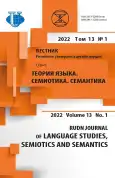Metaphorical Representation of Coronavirus in Medical Myths
- Авторлар: Stepanova E.S.1
-
Мекемелер:
- Samara State Medical University
- Шығарылым: Том 13, № 1 (2022)
- Беттер: 174-183
- Бөлім: SOCIOCOGNITIVE STUDIES
- URL: https://journal-vniispk.ru/2313-2299/article/view/323323
- DOI: https://doi.org/10.22363/2313-2299-2022-13-1-174-183
- ID: 323323
Дәйексөз келтіру
Толық мәтін
Аннотация
This paper focuses on metaphorical representation of coronavirus in medical myths on the example of the British media. To attain this goal, the descriptive metaphor theory is used for the analysis of metaphorical models for the conceptualization of coronavirus. The information about the virus transmitted by the media correlates with background knowledge of the recipient, acquires new conceptual characteristics. Our hypothesis is that metaphorical actualization of coronavirus in medical myths is represented by the descriptive metaphor, the content of which changes depending on the specifics of the spread of the virus over the country as well as the political situation in the country. The research is based on the assumption that metaphorical implications in medical myths influence the representation of the disease, which reflects not only general beliefs about this disease, but also molds the public opinion on political situation in the linguocultural society. The objective of this research is to analyze the titles and leads of the British press about coronavirus and interpret the metaphorical models for the conceptualization of coronavirus, used in medical myths. The objective of the research determined the choice of research methods: content analysis of titles and leads that contain metaphorical models for the conceptualization of coronavirus in medical myths; sampling analysis aimed at identifying and describing the functions of metaphorical models in the representation of the disease in medical myths. The notions of metalanguage such as the signification descriptor and the denotation descriptor are used to describe the functioning of metaphors. The research findings reveal that for the conceptualization of coronavirus in medical myths the following metaphorical models are used: ‘Coronavirus-military rival’, ‘Coronavirus-natural disaster’ and ‘Coronavirus-silver lining’.
Негізгі сөздер
Авторлар туралы
Elena Stepanova
Samara State Medical University
Хат алмасуға жауапты Автор.
Email: pretty.step@bk.ru
SPIN-код: 6992-0076
PhD of Philology, Department of Foreign and Latin Languages 89, Chapaevskaya str., Samara, Russian Federation, 443099
Әдебиет тізімі
- King, K.C. & Hoffman, J.R. (2000). Myths and medicine. Western Journal of Medicine, 172(3), 208. https://doi.org/10.1136/ewjm.172.3.208
- Lakoff, G. & Johnson, M. (1980). Metaphors we live by. Chicago: University of Chicago Press.
- Kövecses, Z. (2016). Conceptual metaphor theory. In: The Routledge Handbook of Metaphor and Language. New York: Routledge. pp. 13-27.
- Davidson, D. (1980). What Metaphors Mean. In: Reference, Truth and Reality: Essay on the Philosophy of Language. London. pp. 238-254.
- Searle, R.J. (1984). Metaphor. In: Metaphor and Thought, Andrew Ortony (ed.). Cambridge: Cambridge University Press. pp. 92-124.
- Walter, J. & Helmig, J. (2005). Metaphors as Agents of Signification. Towards a Discursive Analysis of Metaphors. In: ECPR Granada Workshop Metaphors in Political Science. URL: https://seis.bristol.ac.uk/~potfc/Granada/Papers/Helmig.pdf (accessed: 1.03.2021).
- Simpson, P., Mayr, A. & Statham, S. (2018). Critical Linguistics and Critical Discourse Analysis. In: Language and Power. Milton Park, Abingdon, Oxon; New York: Routledge. pp. 58-65.
- Charteris-Black, J. (2004). Corpus approaches to critical metaphor analysis. Hampshire: Palgrave Macmillan.
- Simpson, P., Mayr, A. & Statham, S. (2018). Critical Metaphor Analysis. In: Language and Power. Milton Park, Abingdon, Oxon; New York: Routledge. pp. 229-236.
- Sweetser, E. (1990). From etymology to pragmatics: metaphorical and cultural aspects of semantic structure. Cambridge: Cambridge University Press.
- Turner, M. & Fauconnier, G. (1995). Conceptual Integration and Formal Expression. Metaphor and Symbolic Activity, 10(3), 183-203.
- Ricoeur, P. (2004). The rule of Metaphor: the Creation of Meaning in Language. London, New York: Routledge.
- Baranov, A.N. (2003). On the Types of Combinability of Metaphorical Models. Voprosy yazykoznaniya, 2, 73-94. (In Russ.).
- Zinken, J., Hellsten, I. & Nerlich, B. (2008). Discourse metaphors. In: Body, Language, and Mind, R. Dirven, R. Frank, T. Ziemke, J. Zlatev (eds.). Vol. 2: Sociocultural Situatedness. Berlin: Mouton. pр. 363-385.
- Li, W. (2016). Rethinking Critical Metaphor Analysis. International journal of English Linguistics, 6(2), 92.
- Stepanova, E.S. (2021). Linguocognitive Specifics of the Disease Myth. RUDN Journal of Language Studies, Semiotics and Semantics, 12(1), 153-164. https://doi.org/10.22363/2313-2299-2021-12-1-153-164
Қосымша файлдар









